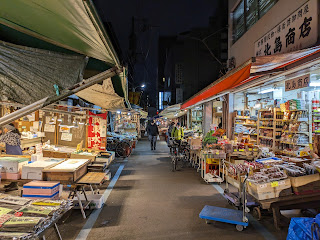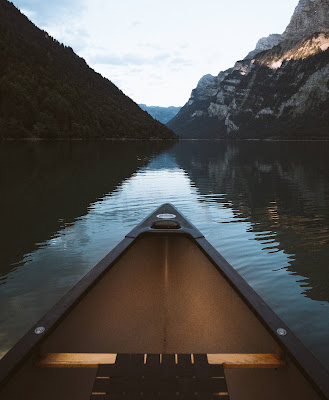I’ve arrived and am working in Tsukiji!! It’s been about 2 weeks since I started working for Saito Suisan Fish Company.
It’s located in central Tsukiji, the old fish market of Tokyo.
Here hundreds of seafood come and go from Toyosu, our new fish market.
Which fish makes the shelf all depends on the sea, so there will be a rare type of crab or fish one day then a different one might come the next day.
It's not a factory. It all depends on the sea, the weather, the nature.
History still here
Tsukiji was a place for professional chefs to come buy their ingredients, mainly seafood. Due to aging the main building now moved to Toyosu, and Tsukiji is becoming more of a tourist spot selling seafood, wagyu, and desserts.
But working here I still see professionals coming to find particular fish, or something different to put on their menu.
Our side as a fish shop will be the conossieur to tell them how the seafood tastes and ideas how to cook them. We support the restaurants to keep the ingredients in the best condition it can be for the use of restaurants and households that value quality over mass sold in supermarkets.
Fish Connoisseur
The amazing part about Japan is fishes have its seasons.
We just had mejimaguro or Blue eye tuna and Kanburi winter yellowtail from Toyama Prefecture.
Most blue eye tunas don't taste very good while the paricular ones like in Toyama, are amazing during winter. The taste gets a lot closer to the more expensive blue fin tuna, while its priced a lot lower, better for customers.
Why is the blue eye tuna in Toyama special? It's due to what the fish eats.When we cut the fish open, there were a bunch of firefly squids, which is another good seafood from the region. You are what you eat, and so do fishes.
Without knowledge and experience as connoisseurs, you won't be able to find the best fish in the main market. I've been finding out that's what makes this fish ship special.
Saba Mackerel is one of my favorite fishes. The ones that come from Oita Prefecture are called Seki Saba, which I adore. It tasted amazing.
Shore Dotterell, a type of sea bass called nodoguro is fished in Akita Prefecture. Nodoguro and kinki is a lot of people's favorite fishes in Japan.
Food in Tsukiji is “reasonable”
Tsukiji was originally for professionals that are willing to pay the price for the best type of ingredients. Ingredients do come from the main market where only licensed professionals have access to, which then of course draws the prices higher.
But fish ware out quickly. So what do we do with the big supply of fish? People that were related to Tsukiji started to sell seafood oitside the main market. They even cooked it for the relativelY wealthy businessmen in Ginza area, who don't know how to cook the ingredients. That evolved to 場外市場 or
Tsukiji Outer Market, which is where my current workplace Saito Suisan Fish Company is.
So food might ne pricier than other areas in Tokyo. But the value you get for the price you pay is reasonable, due to the storage facilities in the area and the competition.
Yes, Tsukiji has become touristic than before and there are people that sell "not very good food for what you pay" dishes.
But when you are passionate in cooking or dining, you'll be able to distinguish the legitimate ones because the basics in business are the same.
So in the end it’s our own responsibility to tell which is worth it and which is not. Plus, the businesses that go for easy money actually do start losing money and end up closing in the long run. The genuine ones stay and can play the long game.
The Olympics of ingredients
I’ve realized that the best parts of seafood, meat, fruits from across Japan come to the Tsukiji/Toyosu area. The best comes to where there is money=Tokyo.
Crabs recently are very scarce and live whole king crab costs over 100,000JPY. But I’ve come across a customer that will pay whatever asking price. But it all depends on nature, and the ocean. Some things are so special and scarce you can’t buy it. Then I would learn that you have to grow inside so you do get trusted and be the one that will get that phone call when the crab do arrive to Tokyo.
Working in the area it’s very good learning how to grow as a person. I learn through seafood, but the essentials can be implemented to other industries. I’m happy I can learn and grow through what I love.
Tsukiji is close to everywhere in Tokyo
Just about 20 minute walk from Tokyo Station, Tsukiji is located very central in the prime area of the city. It’s one train ride to go almost anywhere in Tokyo.
I did some research on where to go for street and traditional Tokyo food then I was able to narrow it
down to these areas to go eat for traditional and inspiring flavors.
- Asakusa
- Ningyocho, Nihonbashi
- Ueno
- Ginza Corridor/Shinbashi
The best high end places to eat will be:
- Ginza
- Roppongi/Azabu Juban
Looking forward to exploring all the foodie areas while I live in Tokyo, and to be updated.
Follow me for more contents!!
Hope the content was helpful! Any comments or questions, let's connect and I'd be happy to help you as much as I can!!
Follow my
personal Instagram which I will start sharing more things food and seafood related.






Comments
Post a Comment